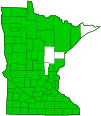hoary puccoon
(Lithospermum canescens)
Conservation • Description • Habitat • Ecology • Use • Distribution • Taxonomy
Conservation Status |
|
|||||||
| IUCN Red List | not listed |
|||||||
| NatureServe | N5? - Secure SNR - Unranked |
|||||||
| Minnesota | not listed |
|||||||
Description |
||
Hoary puccoon is a 4″ to 18″ tall, erect, perennial forb that rises on 1 to 5 stems from a thick, red taproot. The stems are erect and usually unbranched, though sometimes branched near the top. They are densely covered with soft, ascending to spreading, sometimes somewhat tangled hairs. The leaves are alternate, stalkless, relatively thick, lance-shaped to narrowly oblong, ¾″ to 2⅜″ long, and ⅛″ to ½″ wide. There are usually less than 25 leaves below the inflorescence. They are angled or narrowly rounded at the base and bluntly pointed at the tip. Sometimes there is a minute, sharp point at the tip. There is a single prominent vein and no noticeable lateral veins. The upper and lower surfaces are grayish-green and are densely covered with short, fine, loosely ascending to appressed hairs. There are small, elevated, blister-like elevations (pustules) at the base of the hairs on the leaves, though this may not be apparent without a hand lens. The margins are untoothed and have a fringe of soft hairs. The inflorescence is usually 1 to 3 leafy, branched, flower clusters at the end of the stem. Occasionally a plant will produce 1 or 2 additional flowering branches after the first flowering branches have gone to seed. The flowers at the top bloom first, the lateral flowers progressively later. The clusters are dense at first, elongate as the lateral flowers bloom, eventually becoming coiled and 1″ to 4″ long. The flowers are ⅓″ to ½″ wide and funnel-shaped. The sepals are fused at the base into a short, cup-like structure (calyx) then separated into 5 linear, flat, ⅛″ to ¼″ long lobes. The 5 petals are orange to yellow. They are fused at the base into a ¼″ to ⅜″ long floral tube, then separated into 5 spreading, ⅜″ to ⅝″ wide lobes. The lobes are not fringed. There are 5 stamens. The flowers are subtended by bracts that are much longer than the calyx. The flowers have a sweet scent. According to most sources, including Yatskievych & Steyermark and Gleason & Cronquist, there are no closed, self-fertilizing (cleistogamous) flowers. A recent (2012) ongoing study suggests that this may not always be the case. The fruits are 1 to 4 egg-shaped, ⅛″ long, cream-colored, smooth, shiny, hard nutlets. Each nutlet contains 1 seed. |
||
Height |
||
4″ to 18″ |
||
Flower Color |
||
Orange to light golden yellow |
||
Similar Species |
||
Fringed puccoon (Lithospermum incisum) leaves are roughly hairy, not densely, softly hairy. The hairs on the stem and leaves are pustule-based, though this may not be apparent without a hand lens. The inflorescence does not elongate as the season progresses. The floral tube is much longer, ¾″ to 2″ long. In the late spring and summer it becomes much branched with cleistogamous flowers in the leaf axils of the new branches. The fruit is white, not cream-colored. Hairy puccoon (Lithospermum caroliniense var. croceum) often rises on 12 or more stems. The stems are leafier. The leaves are roughly hairy, not densely, softly hairy. The hairs on the stem and leaves are pustule-based, though this may not be apparent without a hand lens. The inflorescence eventually becomes much longer, 2″ to 10″ long. The flowers are larger, ½″ to 1″ wide. The calyx lobes are longer, ¼″ to ½″ long when the plant is in full flower. The floral tube is longer, 9 ⁄16″ to 1″ long. The fruit is white, not cream-colored. |
||
Habitat |
||
Dry to moderate moisture. Prairies, open woods, roadsides. Seldom in sandy soil. |
||
Ecology |
||
Flowering |
||
April to June |
||
Pests and Diseases |
||
|
||
Use |
||
|
||
Distribution |
||||
|
Sources |
|||
| 6/13/2022 | ||||
Nativity |
||||
Native |
||||
Occurrence |
||||
|
||||
Taxonomy |
|||
| Kingdom | Plantae (Plants) | ||
| Division | Tracheophyta (Vascular Plants) | ||
| Subdivision | Spermatophytina (Seed Plants) | ||
| Class | Magnoliopsida (Dicots) | ||
Order |
Boraginales (borages) | ||
Family |
Boraginaceae (borage) | ||
| Subfamily | Boraginoideae | ||
| Tribe | Lithospermeae | ||
Genus |
Lithospermum (stoneseeds, puccoons, and gromwells) | ||
Subordinate Taxa |
|||
|
|||
Synonyms |
|||
Batschia canescens |
|||
Common Names |
|||
hoary gromwell hoary puccoon Indian paint Indian-paint puccoon |
|||
Glossary
Axil
The upper angle where the leaf stalk meets the stem.
Calyx
The group of outer floral leaves (sepals) below the petals, occasionally forming a tube.
Cleistogamous
Automatically self-pollinating. Refers to bud-like flowers that do not open but automatically self-pollinate, or to plants with such flowers.
Linear
Long, straight, and narrow, with more or less parallel sides, like a blade of grass.
Pustule
Small, elevated, blister-like elevations, usually at the base of hairs.
Sepal
An outer floral leaf, usually green but sometimes colored, at the base of a flower.
“Larger, Lighter, Longer”
For a convenient mnemonic to distinguish between hairy puccoon and hoary puccoon in the field, think “Larger, Lighter, Longer."
Hairy puccoon has larger petals that are slightly but noticeably lighter in color and have longer floral tubes.
Visitor Photos |
|||||
Share your photo of this plant. |
|||||
| This button not working for you? Simply email us at info@MinnesotaSeasons.com. Attach one or more photos and, if you like, a caption. |
|||||
Nancy Falkum |
|||||
Hoary puccoon Lithospermum canescens w/ Partridge pea At TNC KWD Cox Unit |
|||||
 |
|||||
Greg Watson |
|||||
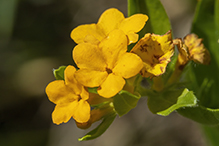 |
|||||
Luciearl |
|||||
Many of these growing in the nearby ditch. Sunny and dry soil. |
|||||
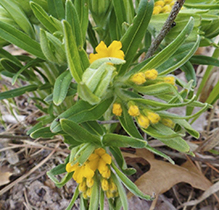 |
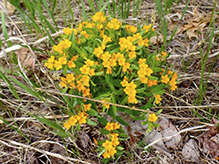 |
||||
Kirk Nelson |
|||||
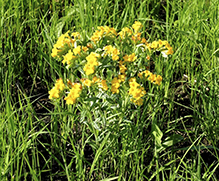 |
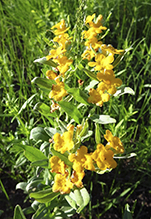 |
||||
MinnesotaSeasons.com Photos |
|||||
Plant |
|||||
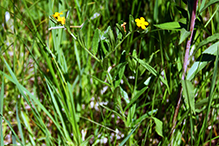 |
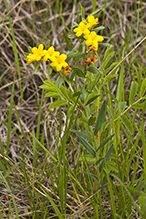 |
||||
Inflorescence |
|||||
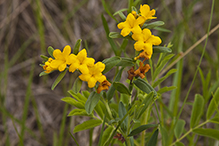 |
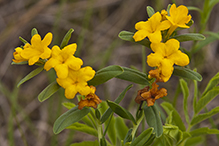 |
||||
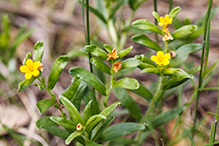 |
|||||
Floral Tube |
|||||
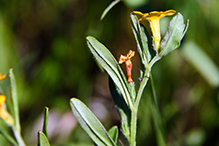 |
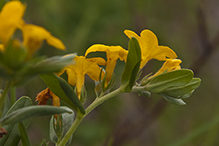 |
||||

Slideshows |
||

Visitor Videos |
|||
Share your video of this plant. |
|||
| This button not working for you? Simply email us at info@MinnesotaSeasons.com. Attach a video, a YouTube link, or a cloud storage link. |
|||
Other Videos |
|||
| Hoary Puccoon Wapello County Conservation Board - Iowa |
|||
About
Nov 2, 202 The Hoary Puccoon prefers dry soils, and is found at the Eddyville Sand Prairie. A short prairie plant, which adds beautiful color the the summer prairie. |
|||
| Hoary Puccoon (Lithospermum canescens) Biophile |
|||
About
May 4, 2021 A video describing Hoary Puccoon, Lithospermum canescens and its heterostyly. Pin and Thrum forms are shown and described. |
|||
| Rocky Woods & Seepy Meadows: Hoary Puccoon Sanders' Wildflowers |
|||
About
Mar 6, 2020 Enjoy a collection of educational videos by Dr. Roger Sanders about the spring wildflowers found throughout the southern Appalachians. These videos are a production of Core Academy of Science, a christian nonprofit based out of Dayton, TN. Donate to the Sanders Fund: Sanders Scholars Program: Social Media: |
|||


|
Created: Last Updated: © MinnesotaSeasons.com. All rights reserved. |
